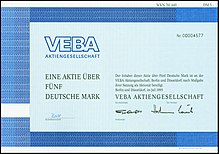VEBA
| VEBA AG
|
|
|---|---|
| legal form | Corporation |
| founding | March 8, 1929 |
| resolution | September 27, 2000 |
| Reason for dissolution | Merger with VIAG |
| Seat | Dusseldorf |
| management | most recently Ulrich Hartmann |
| Number of employees | 130,000 |
| sales | 42.48 billion euros |
| Branch | Energy supply , mining |
The VEBA AG (originally United Electricity and Mining Company ) was a Prussian - German energy -Staatskonzern, who later became a publicly traded corporation was converted and in today's 2000 E.ON rose SE.
history
The umbrella company, Vereinigte Elektrizitäts- und Bergwerks AG , came into being on March 8, 1929 by merging the following mining companies of the Prussian state:
- Prussian electricity stock corporation
- Prussian mining and smelting stock company
- Mining company Hilbernia
- Mining Corporation Recklinghausen
During the Second World War, VEBA used thousands of forced laborers in its mines in Scholven and Horst. According to company information, they had to “work under inhumane conditions”. Many of them died. Estimates assume a total of 3,000 forced laborers.
After the Second World War , VEBA was initially owned by the federal government. After his retirement in 1959, Alfred Hartmann became CEO of VEBA from 1959 to 1966. Hartmann initiated the VEBA privatization; Rudolf von Bennigsen-Foerder (VEBA CEO from 1971 until his death in 1989) continued it and completed it in 1987.
In 1965 the federal government first went public with shares valued at around DM 528 million. In the same year VEBA took over 95 percent of Stinnes AG . In 1972 the VEBA group employed 58,300 people and had an annual turnover of 10.3 billion DM.
In 1974, the new head office in Düsseldorf was completed according to plans by the architect Hubert Petschnigg . In 1975 the mineral oil and chemical division of Gelsenberg Petrol AG was taken over , which was incorporated into the previous Veba Chemie AG and henceforth traded as Veba Oel AG . In the spring of 1977 VEBA's federal stake was 43.7 percent of the shares.
In June 1978 VEBA signed a contract with the mineral oil company BP in which BP delivered 3 million tons of crude oil to VEBA annually up to the year 2000 and in return received shares in Gelsenberg AG amounting to 800 million DM. With the voting rights of Gelsenberg AG, BP sought to obtain a controlling influence on the highly profitable gas business of Ruhrgas AG . The BP project ultimately failed because the other Ruhrgas shareholders in the vote pool were not prepared to sell their voting rights to BP. In December 1982 VEBA Oel AG signed a cooperation agreement with Petróleos de Venezuela (PDVSA) to establish a joint venture called Ruhr Oel GmbH .
Since its introduction on January 1, 1988, VEBA has been listed in the German share index (DAX) . In 1989 the number of shareholders was 600,000. In 1990 the group had 106,900 employees and the annual turnover was 54.591 billion DM. In 1992 VEBA took over the remaining five percent of Stinnes AG (now trading as a stock corporation ). In 1997 VEBA founded the telecommunications company o.tel.o together with RWE .
Towards the end of 1998, around 130,000 people worked in the VEBA Group and achieved a turnover of 42.28 billion euros. Almost 33,000 of them were employed outside Germany .
The history of VEBA ended with the merger with VIAG on September 27, 2000 and E.ON AG was created. VEBA brought in PreussenElektra , Veba Oel, Degussa - Hüls and the majority of the votes in the circle of owners of Ruhrgas AG. In this context, Veba Telecom (in particular a stake with RWE in E-Plus ), MEMC (USA), Stinnes and Veba Electronics were sold.
VEBA CEO
- 1959–1966: Alfred Hartmann
- 1966–1971: Heinz P. Kemper
- 1971–1989: Rudolf von Bennigsen-Foerder
- 1989–1993: Klaus Piltz
- 1993-2000: Ulrich Hartmann
structure
In 1996, the VEBA group consisted of seven subgroups and VEBA AG as the holding company . The subgroups in turn consisted of around 40 strategic business areas.
The divisions were
- the electricity sector with the wholly-owned subsidiary PreussenElektra ,
- the chemistry division with Degussa-Hüls ,
- the oil division with the wholly owned subsidiary VEBA OEL ,
- the distribution / logistics division with the 100 percent subsidiary Stinnes AG (51 percent after the IPO),
- the electronics division with the wholly-owned subsidiary VEBA Electronics ,
- the real estate management division with the wholly owned subsidiaries Raab Karcher and VEBA Immobilien Management and
- the telecommunications sector with the wholly-owned subsidiary Vebacom and O.tel.o (52.5%).
literature
- Heinz-Günter Kemmer: Traces of oil. 50 years of VEBA OEL. Düsseldorf, Vienna Econ (1985)
- Hansgeorg Köster and Thomas König: Value-oriented corporate management at VEBA . In: Peter Horváth (ed.): Innovative controlling tools and concepts from top companies , pp. 47–68, ISBN 3-7910-1353-X
Web links
- Early documents and newspaper articles on VEBA in the 20th century press kit of the ZBW - Leibniz Information Center for Economics .
Individual evidence
- ^ Annual report for the 1929 financial year, page 6. In: 20th century press kit. German Central Library for Economics, accessed on February 8, 2019 .
- ↑ Between coal chemistry and war economy: The Scholven and Horst works 1929-1945. In: BP. Retrieved July 19, 2019 .
- ^ Johannes Fischer: "War model company" Hydrierwerke Scholven AG. In: Gel Center. Retrieved July 19, 2019 .
- ↑ Corporations. Numbers under control , DER SPIEGEL 12/1977 of March 14, 1977 (accessed October 9, 2018)


